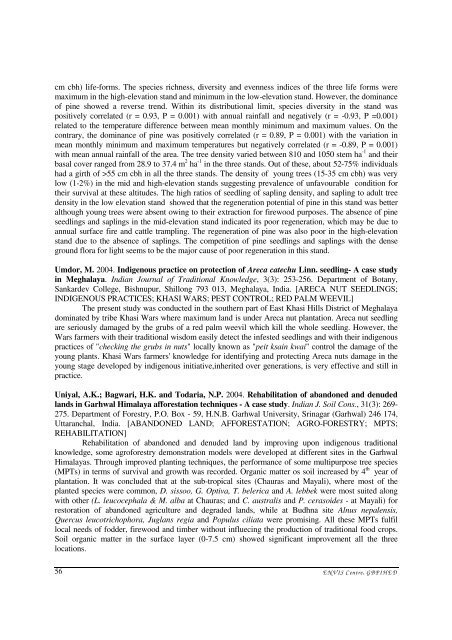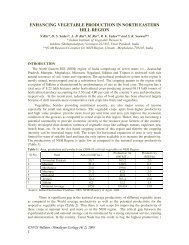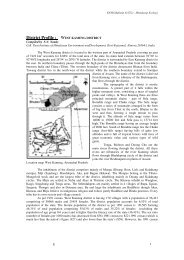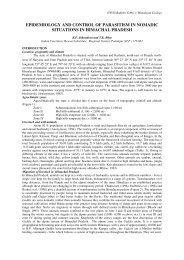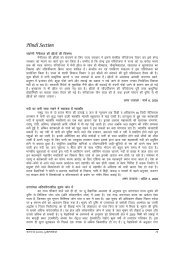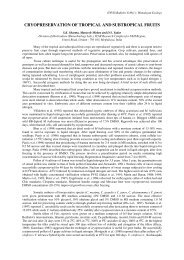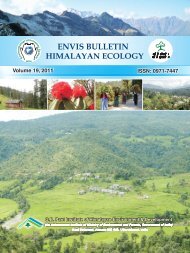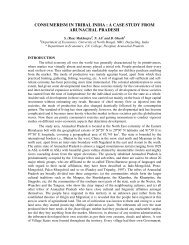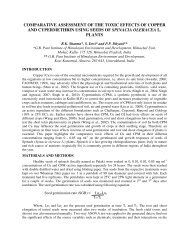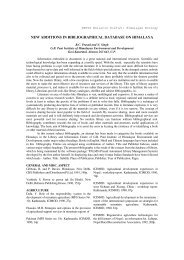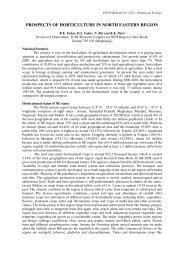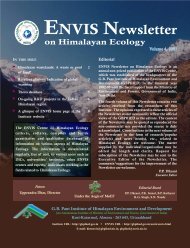ENVIS BULLETIN - ENVIS Centre on Himalayan Ecology
ENVIS BULLETIN - ENVIS Centre on Himalayan Ecology
ENVIS BULLETIN - ENVIS Centre on Himalayan Ecology
You also want an ePaper? Increase the reach of your titles
YUMPU automatically turns print PDFs into web optimized ePapers that Google loves.
cm cbh) life-forms. The species richness, diversity and evenness indices of the three life forms weremaximum in the high-elevati<strong>on</strong> stand and minimum in the low-elevati<strong>on</strong> stand. However, the dominanceof pine showed a reverse trend. Within its distributi<strong>on</strong>al limit, species diversity in the stand waspositively correlated (r = 0.93, P = 0.001) with annual rainfall and negatively (r = -0.93, P =0.001)related to the temperature difference between mean m<strong>on</strong>thly minimum and maximum values. On thec<strong>on</strong>trary, the dominance of pine was positively correlated (r = 0.89, P = 0.001) with the variati<strong>on</strong> inmean m<strong>on</strong>thly minimum and maximum temperatures but negatively correlated (r = -0.89, P = 0.001)with mean annual rainfall of the area. The tree density varied between 810 and 1050 stem ha -1 and theirbasal cover ranged from 28.9 to 37.4 m 2 ha -1 in the three stands. Out of these, about 52-75% individualshad a girth of >55 cm cbh in all the three stands. The density of young trees (15-35 cm cbh) was verylow (1-2%) in the mid and high-elevati<strong>on</strong> stands suggesting prevalence of unfavourable c<strong>on</strong>diti<strong>on</strong> fortheir survival at these altitudes. The high ratios of seedling of sapling density, and sapling to adult treedensity in the low elevati<strong>on</strong> stand showed that the regenerati<strong>on</strong> potential of pine in this stand was betteralthough young trees were absent owing to their extracti<strong>on</strong> for firewood purposes. The absence of pineseedlings and saplings in the mid-elevati<strong>on</strong> stand indicated its poor regenerati<strong>on</strong>, which may be due toannual surface fire and cattle trampling. The regenerati<strong>on</strong> of pine was also poor in the high-elevati<strong>on</strong>stand due to the absence of saplings. The competiti<strong>on</strong> of pine seedlings and saplings with the denseground flora for light seems to be the major cause of poor regenerati<strong>on</strong> in this stand.Umdor, M. 2004. Indigenous practice <strong>on</strong> protecti<strong>on</strong> of Areca catechu Linn. seedling- A case studyin Meghalaya. Indian Journal of Traditi<strong>on</strong>al Knowledge, 3(3): 253-256. Department of Botany,Sankardev College, Bishnupur, Shill<strong>on</strong>g 793 013, Meghalaya, India. [ARECA NUT SEEDLINGS;INDIGENOUS PRACTICES; KHASI WARS; PEST CONTROL; RED PALM WEEVIL]The present study was c<strong>on</strong>ducted in the southern part of East Khasi Hills District of Meghalayadominated by tribe Khasi Wars where maximum land is under Areca nut plantati<strong>on</strong>. Areca nut seedlingare seriously damaged by the grubs of a red palm weevil which kill the whole seedling. However, theWars farmers with their traditi<strong>on</strong>al wisdom easily detect the infested seedlings and with their indigenouspractices of "checking the grubs in nuts" locally known as "peit ksain kwai" c<strong>on</strong>trol the damage of theyoung plants. Khasi Wars farmers' knowledge for identifying and protecting Areca nuts damage in theyoung stage developed by indigenous initiative,inherited over generati<strong>on</strong>s, is very effective and still inpractice.Uniyal, A.K.; Bagwari, H.K. and Todaria, N.P. 2004. Rehabilitati<strong>on</strong> of aband<strong>on</strong>ed and denudedlands in Garhwal Himalaya afforestati<strong>on</strong> techniques - A case study. Indian J. Soil C<strong>on</strong>s., 31(3): 269-275. Department of Forestry, P.O. Box - 59, H.N.B. Garhwal University, Srinagar (Garhwal) 246 174,Uttaranchal, India. [ABANDONED LAND; AFFORESTATION; AGRO-FORESTRY; MPTS;REHABILITATION]Rehabilitati<strong>on</strong> of aband<strong>on</strong>ed and denuded land by improving up<strong>on</strong> indigenous traditi<strong>on</strong>alknowledge, some agroforestry dem<strong>on</strong>strati<strong>on</strong> models were developed at different sites in the GarhwalHimalayas. Through improved planting techniques, the performance of some multipurpose tree species(MPTs) in terms of survival and growth was recorded. Organic matter os soil increased by 4 th year ofplantati<strong>on</strong>. It was c<strong>on</strong>cluded that at the sub-tropical sites (Chauras and Mayali), where most of theplanted species were comm<strong>on</strong>, D. sissoo, G. Optiva, T. belerica and A. lebbek were most suited al<strong>on</strong>gwith other (L. leucocephala & M. alba at Chauras; and C. australis and P. cerasoides - at Mayali) forrestorati<strong>on</strong> of aband<strong>on</strong>ed agriculture and degraded lands, while at Budhna site Alnus nepalensis,Quercus leucotrichophora, Juglans regia and Populus ciliata were promising. All these MPTs fulfillocal needs of fodder, firewood and timber without influecing the producti<strong>on</strong> of traditi<strong>on</strong>al food crops.Soil organic matter in the surface layer (0-7.5 cm) showed significant improvement all the threelocati<strong>on</strong>s.56E N V IS C entre, G B P IH E D


